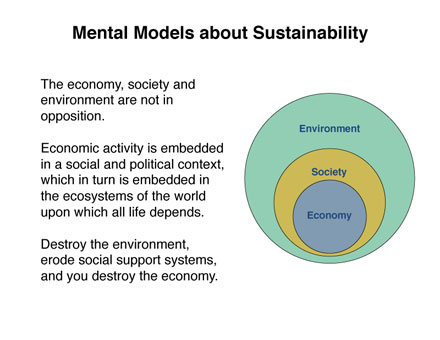Leverage Points for Creating a Sustainable World
Jason Jay, director of the MIT Sloan Initiative for Sustainable Business and Society, says that technology and innovation, coupled with a voluntary “limits to growth,” are key for creating a more sustainable world.
Leading Sustainable Organizations

Jason Jay, a lecturer at the MIT Sloan School of Management, is the director of the MIT Sloan Initiative for Sustainable Business and Society.
If there is only one world, then how are we to conceive of sustainability issues? If political and ideological boundaries really are “invisible fences in the mind,” as MIT Sloan professor John Sterman puts it, then what kind of image of how the world works will best serve us as we think about issues of economic growth?
These are some of the questions that MIT Sloan’s Jason Jay raised in a thought-provoking presentation called “Natural Capital and the Challenge of Sustainable Development” at the Dynamics of Globalization Executive Education program held at MIT on June 13-14.
A lecturer at the MIT Sloan School of Management, Jay is the director of the MIT Sloan Initiative for Sustainable Business and Society. His research generally focuses on cross-sectoral collaboration and hybrid organizations that promote more sustainable business practices, and he gets students and alumni engaged in hands-on projects with leading companies and organizations.
Jay says that MIT Sloan considers economic activity as something embedded in a larger social and environmental context, and defines sustainability as “the fundamental alignment of healthy organizations, healthy environments, healthy societies and economies that meet human needs.”

Excerpted from “Natural Capital and the Challenge of Sustainable Development,” June 13-14, 2012; adapted from the work of Herman Daly and John Sterman.
Societies, he says, can only be sustainable if they are able to meet three basic criteria: renewable resources aren’t used faster than they can be regenerated; pollution and wastes are emitted no faster than natural systems can render them harmless; and non-renewable resources are used no faster than renewable substitutes can be introduced.
So how are we doing? In a nutshell, not great. Jay shared some detailed graphics from a recent article in Nature by Johann Rockström, an interactive chart recently published by the Guardian and a recent McKinsey analysis to paint a picture of a world that looks like it’s rapidly approaching its environmental limits.


Comments (3)
another.human.factor
another.human.factor
Disruptive innovation and sustainable development « Value Chain Generation